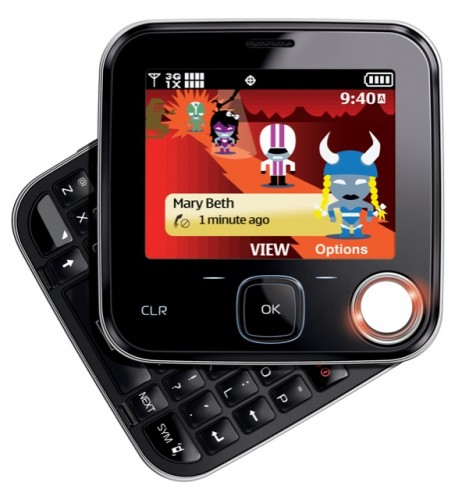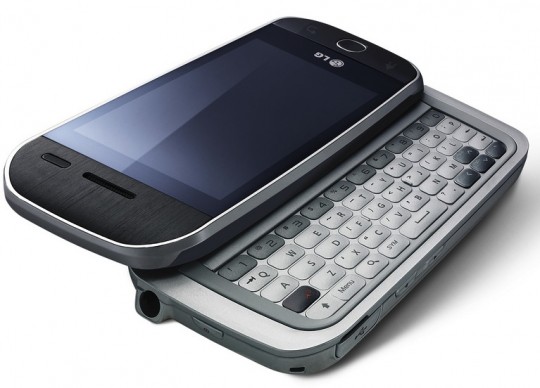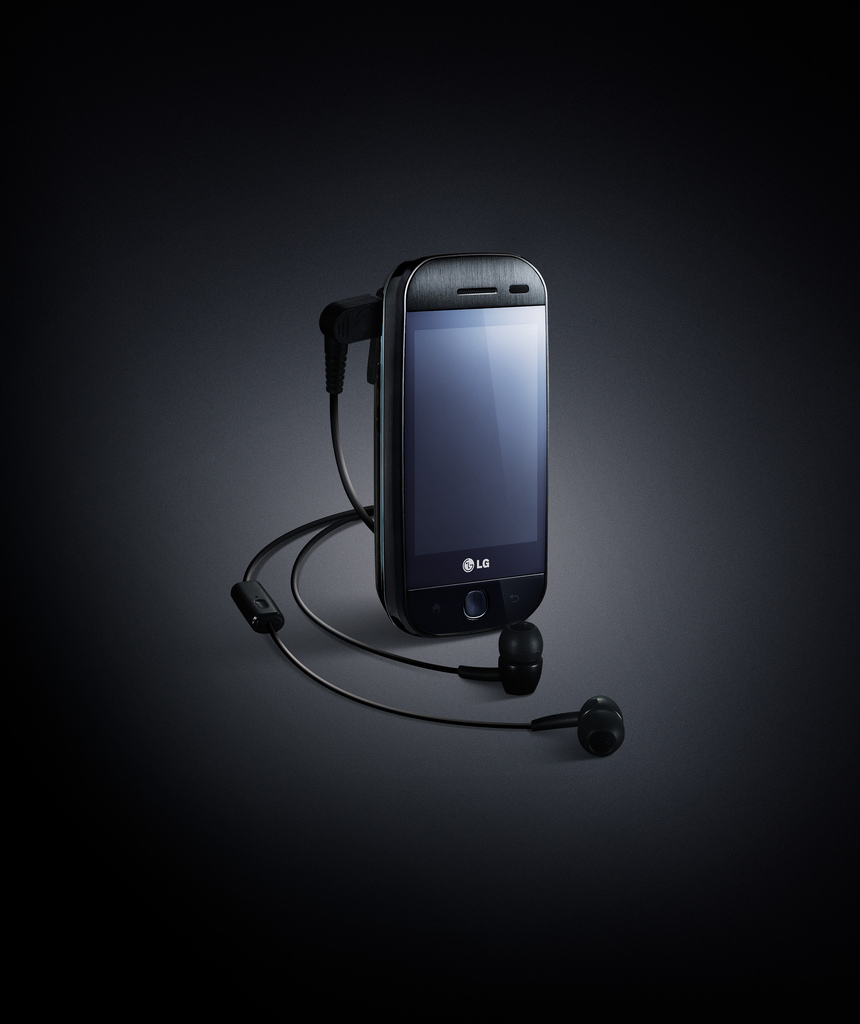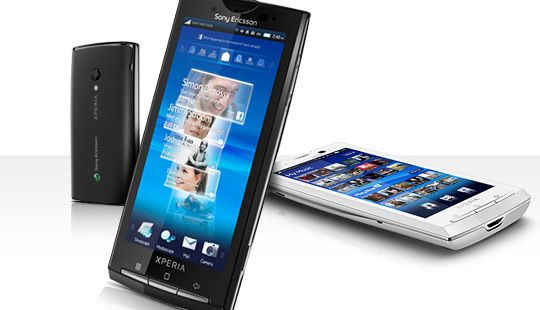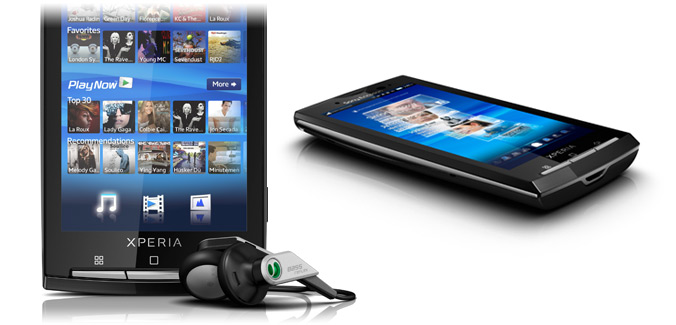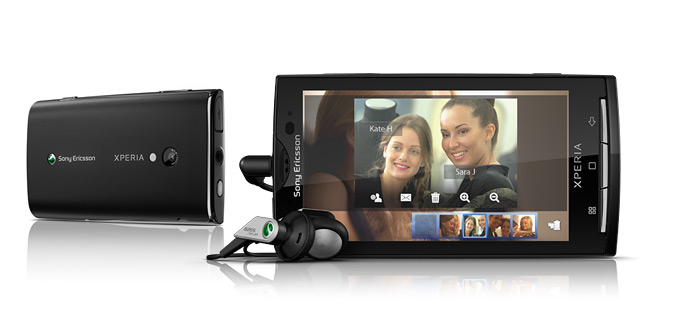The 7705 Twist has a 1,000-contact phone book with room in each entry for five phone numbers, two e-mail addresses, a street address, and notes. You also can save a dedicated emergency number. For further personalization, you can save callers to groups and pair them with a photo and one of 15 72-chord polyphonic ringtones. You even can assign friends a color for the contact ring. A unique feature of the Twist is its "Habitat" mode. After picking one of two display themes ("urban" or "jungle"), your contacts will be represented by avatars in order of the last person called. Click on each avatar to see a list of messages and calls between you and that contact.
Essential features include a calculator, a calendar, an alarm clock, a stopwatch, a world clock, a notepad, a tip calculator, a unit and currency converter, and a speakerphone. You'll also find speaker-independent voice dialing, Bluetooth, PC syncing, USB mass storage, text-to-speech, and support for VZ Navigator.
Besides threaded text and multimedia messaging, there's instant messaging, and e-mail. POP3 e-mail access for accounts such as AOL, Yahoo, and Hotmail is limited to a clunky Web-based interface, but RemoSync service offers access to push e-mail from corporate accounts as well as calendar, notes, and contacts syncing. The initial sync took a few minutes, but after that the process as pretty smooth and you can view some e-mail attachments.
Wednesday, November 11, 2009
Tuesday, November 10, 2009
LG GW620
By Chris Davies on Thursday, Nov 5th 2009
Remember the LG GW620, the QWERTY slider Android smartphone that rocked up with its own mini-site last week? The handset has now made its way to Canada for a debut as the Rogers Wireless LG Eve, promising a Social Network Services (SNS) Manager that pulls together Twitter, Facebook and Bebo updates, a 5-megapixel autofocus camera and – stealing a jump on the Sony Ericsson XPERIA X10 – automatic face recognition tying images into contacts entries.
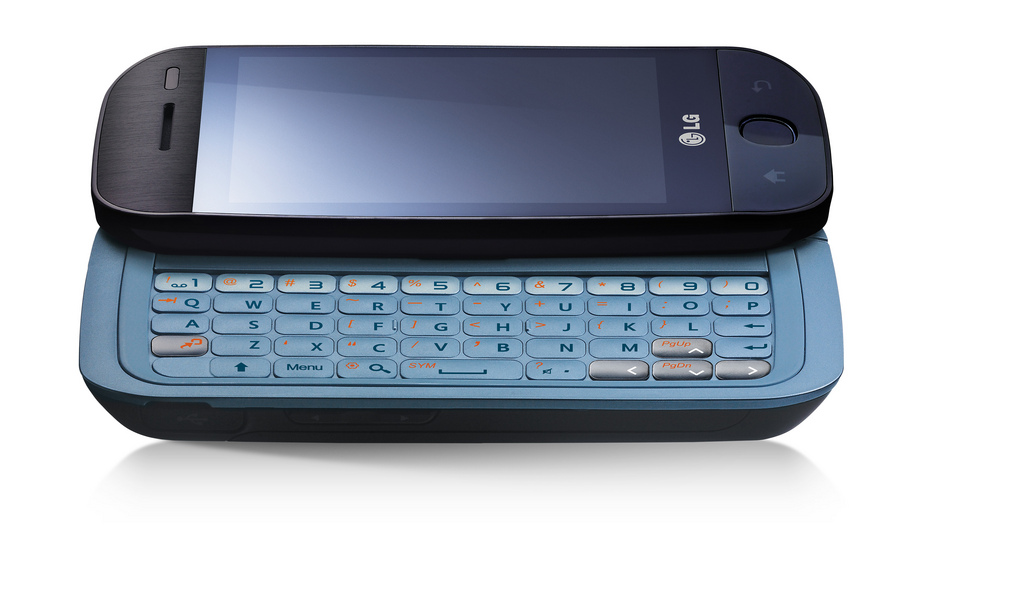 There’s also a 3-inch resistive touchscreen of course, and a 5-row hardware keyboard, together with quadband GSM and triband HSPA connectivity (at least, according to the product page; the tech specs only list 850/1900 support). The Eve gets WiFi, Bluetooth, GPS and an accelerometer, together with a microSD slot and a 2GB card in the box.
There’s also a 3-inch resistive touchscreen of course, and a 5-row hardware keyboard, together with quadband GSM and triband HSPA connectivity (at least, according to the product page; the tech specs only list 850/1900 support). The Eve gets WiFi, Bluetooth, GPS and an accelerometer, together with a microSD slot and a 2GB card in the box.
Rogers are promoting the LG Eve as the “ultimate smartphone for social networking”, something we reckon Motorola and HTC might argue with, but we’ll have to wait until the first reviews in order to see whether that’s accurate or otherwise. The LG Eve is on sale now at Rogers Wireless stores from $49.99 with a three-year agreement (voice and data); it’s currently listed as out of stock online.
Remember the LG GW620, the QWERTY slider Android smartphone that rocked up with its own mini-site last week? The handset has now made its way to Canada for a debut as the Rogers Wireless LG Eve, promising a Social Network Services (SNS) Manager that pulls together Twitter, Facebook and Bebo updates, a 5-megapixel autofocus camera and – stealing a jump on the Sony Ericsson XPERIA X10 – automatic face recognition tying images into contacts entries.
 There’s also a 3-inch resistive touchscreen of course, and a 5-row hardware keyboard, together with quadband GSM and triband HSPA connectivity (at least, according to the product page; the tech specs only list 850/1900 support). The Eve gets WiFi, Bluetooth, GPS and an accelerometer, together with a microSD slot and a 2GB card in the box.
There’s also a 3-inch resistive touchscreen of course, and a 5-row hardware keyboard, together with quadband GSM and triband HSPA connectivity (at least, according to the product page; the tech specs only list 850/1900 support). The Eve gets WiFi, Bluetooth, GPS and an accelerometer, together with a microSD slot and a 2GB card in the box.Rogers are promoting the LG Eve as the “ultimate smartphone for social networking”, something we reckon Motorola and HTC might argue with, but we’ll have to wait until the first reviews in order to see whether that’s accurate or otherwise. The LG Eve is on sale now at Rogers Wireless stores from $49.99 with a three-year agreement (voice and data); it’s currently listed as out of stock online.
Thursday, November 5, 2009
Sony Ericsson XPERIA X10
GSMArena team, 03 November 2009
With the X10 Sony Ericsson have gone from zero to hundred in a split second. While they may know their way around high-end devices, pulling off an undertaking such as the XPERIA X10 must have been a special challenge. And they have yet to get to the finish.
The thing is that Sony Ericsson XPERIA X10 is the first Android smartphone by Sony Ericsson. It's also a Snapdragon first for the company, and they've even come up with a first of its kind proprietary Android UI. Making the X10 a reality seems like a long way full of potential pitfalls for a company that hasn't still recovered from its financial woes.
But the XPERIA X10 or Rachael, or X3, or whatever it has been called in the long months of development, seems like a device that's worth all the hard work.
Even more so, X10 will not be a solitary device but more of a high-flying start for a full-blown platform of Android devices with their own distinct interface and user experience. That kinda sounds familiar. A year and a half ago, we were again there listening to Sony Ericsson presenting the XPERIA X1 in much the similar words. Well, let's hope they'll have better luck with starting off and developing this new part of their portfolio this time.
We had the pleasure of attending a very limited press event held in London, at which Sony Ericsson presented their latest and greatest before they showcase it for the general public. Much like attending a press-only movie screener we had the opportunity to gather some first-hand impressions of what is probably going to be the Sony Ericsson flagship next year. But before making our first go at the XPERIA X10, let's recap its features.
Take the Android OS version, for instance. Despite all the hopes for getting the latest and greatest of the Android crop, Sony Ericsson are serving a cold meal to all the gadget lovers out there. They refused to comment any further on the matter but perhaps all is not lost. Our best guess is they'll have some hard time adjusting their proprietary UI for Android 2.0 (Eclair) so they prefer to stick to 1.6 for the time being in an effort to get the XPERIA X10 out in the market as soon as possible.
And the current plans for the X10 availability say Q1 2010. Yup, missing the holiday season and shipping the handset during the tight-pocketed January and February is certainly the last thing they'd like to do, but proper product development obviously demands it.
Speaking of which, the Sony Ericsson X10 units presented at the event were devilishly fast in all Android tasks and applications, but the proprietary UI by Sony Ericsson clearly needed a lot more work.
With the X10 Sony Ericsson have gone from zero to hundred in a split second. While they may know their way around high-end devices, pulling off an undertaking such as the XPERIA X10 must have been a special challenge. And they have yet to get to the finish.
The thing is that Sony Ericsson XPERIA X10 is the first Android smartphone by Sony Ericsson. It's also a Snapdragon first for the company, and they've even come up with a first of its kind proprietary Android UI. Making the X10 a reality seems like a long way full of potential pitfalls for a company that hasn't still recovered from its financial woes.
But the XPERIA X10 or Rachael, or X3, or whatever it has been called in the long months of development, seems like a device that's worth all the hard work.
Even more so, X10 will not be a solitary device but more of a high-flying start for a full-blown platform of Android devices with their own distinct interface and user experience. That kinda sounds familiar. A year and a half ago, we were again there listening to Sony Ericsson presenting the XPERIA X1 in much the similar words. Well, let's hope they'll have better luck with starting off and developing this new part of their portfolio this time.
We had the pleasure of attending a very limited press event held in London, at which Sony Ericsson presented their latest and greatest before they showcase it for the general public. Much like attending a press-only movie screener we had the opportunity to gather some first-hand impressions of what is probably going to be the Sony Ericsson flagship next year. But before making our first go at the XPERIA X10, let's recap its features.
Sony Ericsson XPERIA X10 at a glance:
- General: GSM 850/900/1800/1900 MHz, UMTS 900/1900/2100 MHz, HSDPA, HSUPA
- Form factor: Touchscreen bar phone
- Dimensions: 119 x 63 x 13 mm, 135 g
- Display: 4" 262K-color TFT capacitive touchscreen, 854 x 480 pixels
- Platform: Qualcomm QSD8250 Snapdragon 1 GHz processor
- OS: Android 1.6 (Donut)
- Memory: 1GB storage, 256MB RAM, microSD card slot, 8GB card included in the retail box
- Camera: 8 megapixel auto-focus camera with LED flash and face detection
- Connectivity: Wi-Fi, Bluetooth 2.1 with A2DP, standard microUSB port, GPS receiver with A-GPS, 3.5mm audio jack
- Misc: Sony Ericsson custom social networking and media UI, built-in accelerometer
Take the Android OS version, for instance. Despite all the hopes for getting the latest and greatest of the Android crop, Sony Ericsson are serving a cold meal to all the gadget lovers out there. They refused to comment any further on the matter but perhaps all is not lost. Our best guess is they'll have some hard time adjusting their proprietary UI for Android 2.0 (Eclair) so they prefer to stick to 1.6 for the time being in an effort to get the XPERIA X10 out in the market as soon as possible.
And the current plans for the X10 availability say Q1 2010. Yup, missing the holiday season and shipping the handset during the tight-pocketed January and February is certainly the last thing they'd like to do, but proper product development obviously demands it.
Speaking of which, the Sony Ericsson X10 units presented at the event were devilishly fast in all Android tasks and applications, but the proprietary UI by Sony Ericsson clearly needed a lot more work.
Wednesday, November 4, 2009
Samsung Omnia HD 2
Samsung's top tier of Omnia devices is populated by some seriously heavy-hitters - first the 720p video recording Omnia HD and now the Omnia II - with its best-in-the-business display, WM 6.5, zippy processor and preloaded software galore, it will certainly win the hearts and minds of Windows Mobile fans.
It's no secret that the Samsung Omnia II has the HTC Touch Diamond2 in its sights. The Omnia II has several advantages, not the least of which is the amazing 3.7" AMOLED WVGA display. For the acronym-allergic - WVGA means 480 x 800 pixels resolution, which several years ago might have been considered acceptable for a computer monitor. That resolution is not so uncommon today, the exciting part here is "AMOLED" - active matrix organic LED. Or in plain English - brilliant picture quality.
It doesn't end there - the 800MHz CPU is one of the speediest around and the available capacities of up to 16GB built-in memory and up to 32GB external storage via microSD card offer more than enough memory expansion. There's Wi-Fi and GPS, the autofocus camera shoots 5MP stills and D1 video at 30fps and has dual-LED flash, there's DivX playback out of the box and HSDPA and HSUPA push the phone to great wireless speeds.
We can spend a lot of time talking about the features of the Omnia II but here they are in a bullet list, which should be easier to read.
Key features:
- 3.7-inch 65K-color resistive AMOLED touchscreen, 480 x 800 pixels
- Windows Mobile 6.5 with TouchWiz UI 2.0 and Media Gate 3D
- Samsung S3C6410 800MHz processor; HW Graphic Accelerator
- 256MB RAM
- 5 megapixel auto focus camera with LED flash, geotagging, face detection, smile shot, image stabilizer, Wide Dynamic Range (WDR)
- Records video in D1@30fps, QVGA slow-mo video recording
- Tri-band 3G with HSDPA (7.2Mbps) and HSUPA (5.76 Mbps) support
- Quad-band GSM support
- Smart dialing
- Wi-Fi with DLNA technology
- Built-in GPS with A-GPS functionality
- 2/8/16GB internal memory
- microSD card slot (up to 32GB)
- FM radio with RDS
- Bluetooth and USB v2.0
- 3.5mm standard audio jack
- TV-out functionality
- DNSe audio technology and SRS sound effect
- DivX/XviD video playback
- Proximity sensor for screen auto turn-off and ambient light sensor
- Accelerometer sensor for automatic UI rotation, turn-to-mute and motion-based gaming
- Office document editor
- Full Flash support in the web browser
Main disadvantages:
- No xenon flash
- No camera lens cover
- 65K color limitation of display results in banding in color gradients
- microSD slot is under the back cover
- Browser has issues with Flash support
Nokia 5530 XpressMusic
Nokia 5530 XpressMusic touches all the right notes for music lovers
June 15, 2009
June 15, 2009
Espoo, Finland - Nokia today introduced the Nokia 5530 XpressMusic, a compact XpressMusic device that uses a touch interface for accessing people and content on the brilliantly clear homescreen. The 'scrolling' Contacts Bar provides direct access to 20 people and their latest conversations and media updates. The homescreen also features one touch shortcuts to content and popular social networks, like Facebook and MySpace. The Nokia 5530 XpressMusic follows in the footsteps of the top-rated Nokia 5800 XpressMusic, expanding the touch XpressMusic phone range with a youthful device that has a solid stainless steel frame finish and comes in five vivid colors.
At the core of the Nokia 5530 XpressMusic is the music and entertainment experience. It is an ideal device for those who wish to quickly and easily access, share and mix a huge selection of media. In true XpressMusic form, the Nokia 5530 XpressMusic is a great music player with 27 hours of playback time, excellent audio quality and a 4 GB memory card for storing music and other media. Videos, either self made or from social media sites such as Youtube and Facebook can be enjoyed on the brilliantly clear 2.9 inch widescreen display. New music can be purchased through the Nokia Music Store, either directly on the phone or through a PC. The music collection is easily managed and can be synchronized with the PC using the Nokia Music for PC application. Calls and music can be conveniently managed and listened to with the Nokia Stereo Headset WH-205 with tangle-free cable.
The innovative 'people carousel' features thumbnail images of up to 20 close friends and provides easy access to them and their communications history including emails, phone calls, photos or other social media updates. The Nokia 5530 XpressMusic also features the pop-up Media Bar so music, photos, videos, Internet and on-line sharing applications such as Ovi Share, Flickr and VOX are just a touch away.
The Nokia 5530 XpressMusic supports GSM/EDGE networks and also offers fast and affordable access to internet services via the integrated wireless LAN over the ubiquitous wireless networks. Nokia is collaborating with Boingo and offers three months of free Internet access in select markets. Boingo works with hundreds of hotspot operators around the world in familiar locations such as airports, hotels, coffee shops and restaurants.
The Nokia 5530 XpressMusic is expected to begin shipping in the third quarter of 2009 at an estimated retail price of EUR 199 before taxes and subsidies.
Motorola CLIQ
The CLIQ is a heavy phone. I don't just mean physically — it makes a weighty impression after using it for just an hour. Besides some nice convenience features (like a headphone jack), the phone's real secret weapon is the MOTOBLUR software, which leverages the Android OS to better organize everything on your phone that doesn't involve calls. Which these days is a lot.
More after the jump.
Physically, at 5.7 ounces, the CLIQ is surprisingly heavy, but it was hard to figure out why. You get Android's pop-up touch QWERTY as well as a three-line slide-out QWERTY keypad, which is easier to handle with easier-to-read keys than the keyboard on the first-ever Android phone, the HTC-made G1, but tougher to type on. The keys are packed tight and require a solid press to register. Along with a 5MP camera, there's a headphone jack, annoyingly missing from both the G1 and the MyTouch 3G. The rear has a sure-grip texturized rubber surface.
To minimize the number of hard buttons on the front panel and thereby create more room for the touchscreen, Motorola has removed the physical Send and End keys and moved them to the touchscreen, along with a Contacts touch key. To make the screen more readable and to save power, the display has an ambient light sensor to automatically adjust brightness. The battery savings goes to talk time — CLIQ is rated to get an impressive 7.5 hours
Even if CLIQ's physical amenities were awful, its exploitation and expansion of Android alone make it the new Android standard, setting a new paradigm for organizing the ever-increasing number of a cellphone's non-verbal communications. The philosophy behind the CLIQ and Motorola's MOTOBLUR Android-plus interface is that there's no reason to keep track of multiple social networking, messaging and e-mail accounts. When you initially set-up the CLIQ, it prompts you for all your e-mail and social-network information. It aggregates all the data from all these sources — all contacts with phone numbers, e-mail addresses, etc. (but maintains the original data within their individual applications) to create on big, super-meta file. For instance, you can choose one picture of yourself from all your accounts to be your caller ID photo to others.
You now get three onscreen dialog bubbles (at least that's what they look like to me). "Messages" collects all your incoming one-to-one messages, "Happenings" collects all social networking feeds, and "Social Status" aggregates all your personal status messages. Tap on one dialog bubble and you can swipe through all categories of communications, regardless of source, and you can reply easily via any source. For instance, if you get an e-mail, you can respond via text simply by choosing this option from a list in the message window. If someone writes on your Facebook wall, you can reply via e-mail. You can broadcast a blast to all your peeps on multiple networks, or just one. You can update your status on all your social networks at one time.
You also can opt to display dialog bubbles for individual Yahoo Widget RSS feeds. If you don't like swiping through sequential dialog bubbles — and you will — you can simply view them listed in a more convenient swipe-scrollable list.
All of these dialog bubbles can really crowd the home screen panels on the 3.1-inch screen, so Motorola has expanded Android's three home panels to five. Even still, any shortcuts you've dragged from the app menu silo to the home screen are apt to get buried underneath the multiple dialog bubbles.
MOTOBLUR also replaces Android's photo gallery with a far superior swipeable gallery with cool 3D transitions, not only from photo-to-photo but even as the accelerometer turns a photo to fill the screen. And of course you can broadcast one or multiple photos to some or all of your social networks.
Since MOTOBLUR's reorganization of the CLIQ's non-verbal communications is so radically different, it took almost the full allotted hour to grok it. But once we did, it was clear its radical efficiencies render mere talking an annoying inconvenience.
Tuesday, November 3, 2009
LG GD510
Seoul, Korea / September 30, 2009 - LG Electronics (LG), a global leader and technology innovator in consumer electronics, today unveiled the LG GD510, or more simply, “Pop”, the most compact 3-inch full touchscreen phone ever made. The LG GD510 is the handset people who want a simple touchscreen phone have been waiting for.
LG has been one of the industry’s leading innovators in touchscreen phones since it launched the world’s first full touchscreen phone, PRADA Phone by LG, in January 2007. Since then, the company has achieved great success in the touchscreen devices market by creating an array of handsets designed to meet different consumer needs. For instance, LG’s Cookie (KP500) is an affordable full touchscreen phone that has already sold more than 7 million units worldwide since its launch earlier this year. With the LG GD510, LG is applying its tried and true strategy to another new model – this time, to a compact full touchscreen handset.
LG’s consumer research showed that a large group of consumers wanted the functionality of a full touchscreen phone without the extra bulk and unnecessary features that resulted in higher prices. According to the research, many users were also put off by the complexity of feature-laden phones but still desired the easier navigation and larger screens of full touchscreen phones. The LG GD510 was designed to include the key features these users craved, without the overhead of features they didn’t use.
“We gave the LG GD510 an optimized feature set which allowed us to concentrate on making the phone more compact and simpler to use,” said Dr. Skott Ahn, President and CEO of LG Electronics Mobile Communications Company. “Our high-end phones like the Black Label Series New LG Chocolate (LG BL40) may be getting all the attention but there’s a gap in the market for affordable touchscreen phones that we want to fill. The LG GD510 delivers all the essentials in communication, multimedia and entertainment and comes in a compact form factor as well.”
Fully fluent in multimedia, the LG GD510 plays music and movies in several popular file formats. An easy-to-use browser brings all the best mobile content to the device’s large screen and a 3.0 megapixel camera captures high quality photos and videos for sharing online or sending wirelessly to friends.
The spacious 3-inch WQVGA touchscreen extends almost to the edges of the LG GD510 with a narrow 4.8 mm bezel giving the illusion of an uninterrupted sheet of glass. The unit’s sleek design is accented by a single button on the face that functions as the menu, end and cancel keys, depending on the phone’s mode. A slim strip of light around the button shines either green or red to indicate the handset’s function. The LG GD510 is crafted from brushed aluminum which gives it a high-end look and feels solid in the hand even when squeezed.
LG GD510 will be available beginning in mid-October in Europe, followed by other markets. Prices will vary country-to-country and will be announced separately in each individual market
Subscribe to:
Posts (Atom)
